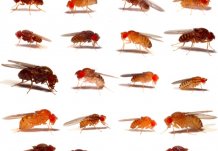
Drosophilidae flies (Photo credit Darren Obbard)
Viruses can evolve in parallel in related species
Viruses are more likely to evolve in similar ways in related species – raising the risk that they will “jump” from one species to another, new research shows.
Scientists from the universities of Exeter and Cambridge compared viruses that evolved in different species and found “parallel genetic changes” were more likely if two host species were closely related.
The findings suggest that when a new virus appears in a species such as chimpanzees, closely related species like humans may become vulnerable too.
Such jumps, also known as host shifts, are a major source of infectious disease, with viruses such as HIV, Ebola and SARS coronavirus all thought to have jumped into humans from other species.
The researchers used deep sequencing of genomes to track the evolution of viruses in 19 species of flies.
“Our findings show that when a virus adapts to one host, it might also become better adapted to closely related host species,” said Dr Ben Longdon, of the University of Exeter.
“This may explain in part why host shifts tend to occur between related species. However, we sometimes see the same mutations occurring in distantly related host species, and this may help explain why viruses may sometimes jump between distantly related host species.
“At present we know very little about how viruses shift from one host species to another, so research like this is important if we want to understand and ultimately predict emerging viral diseases.”
The fruit flies used in the study were 19 species from the Drosophilidae family, which shared a common ancestor 40 million years ago.
The paper, published in the journal PLOS Pathogens, is entitled: “Host shifts result in parallel genetic changes when viruses evolve in closely related species.”
Date: 12 April 2018
